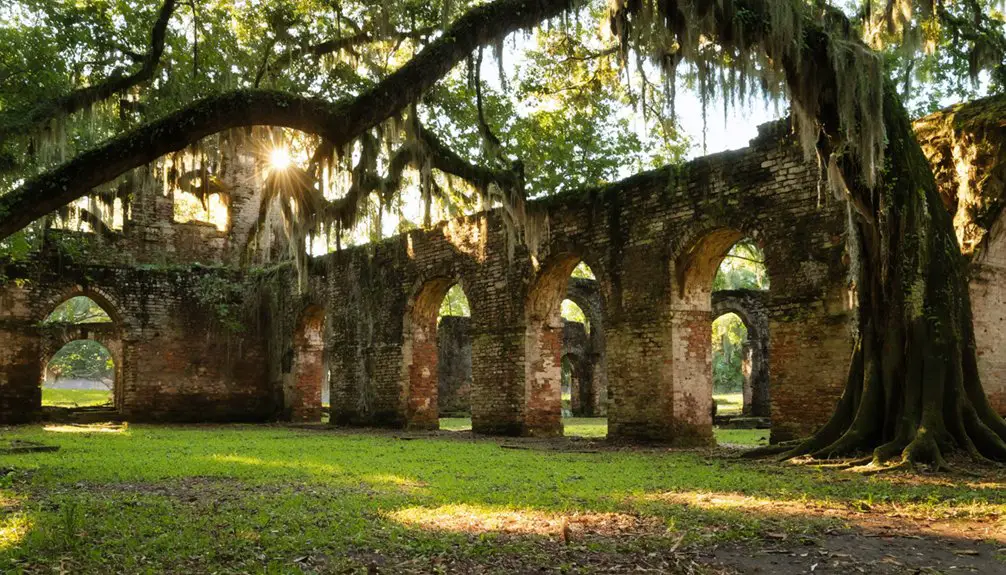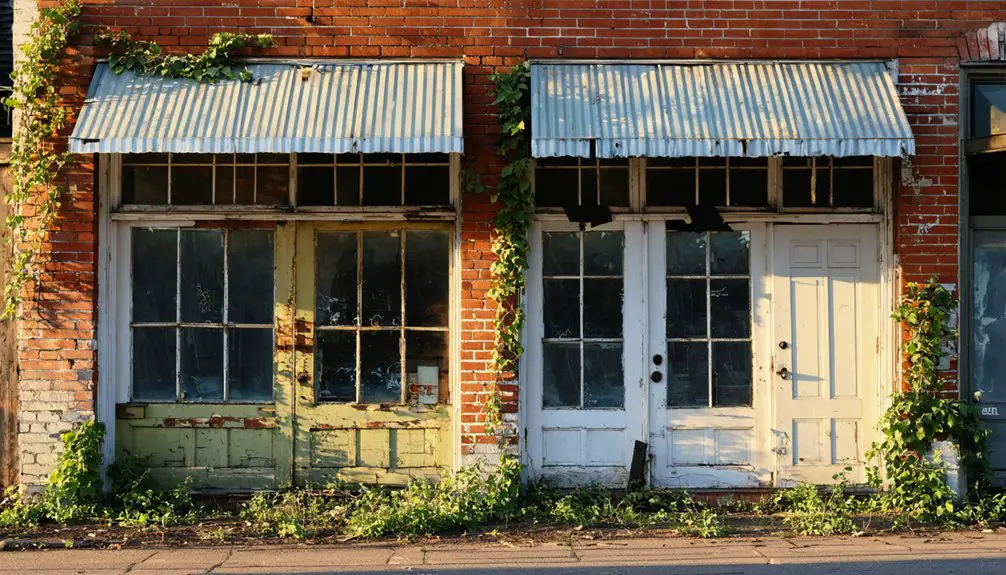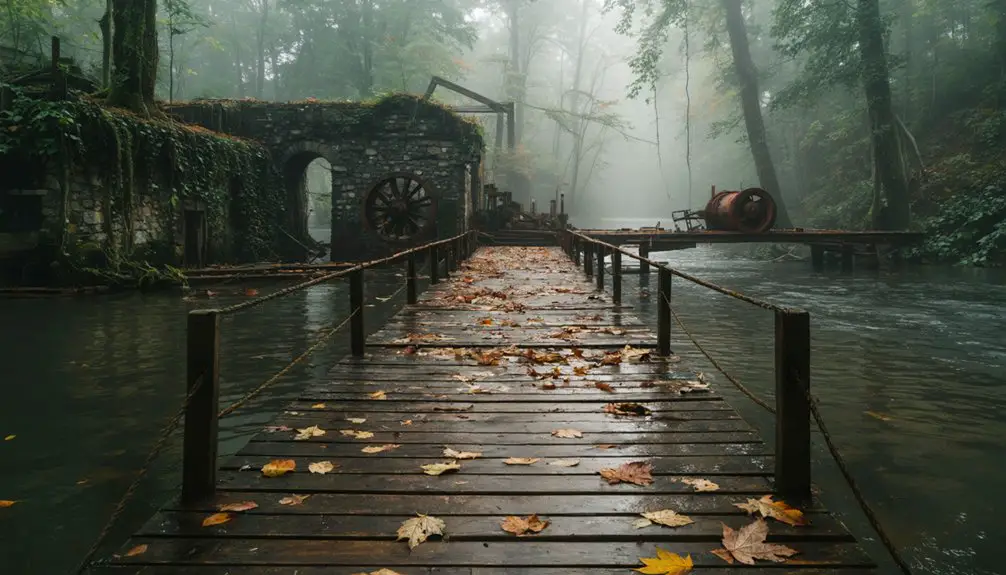You’ll find Brunswick Town’s haunting ruins along North Carolina’s Cape Fear River, where a bustling colonial port once shaped American resistance to British rule. The town flourished from 1726 to 1776 through maritime trade and royal governance until British forces burned it during the Revolution. Today, you can explore the preserved remains of St. Philip’s Church, colonial foundations, and maritime artifacts that tell the story of this strategic settlement’s dramatic rise and fall.
Key Takeaways
- Brunswick Town was established in 1726 as a major colonial port but became a ghost town after British forces destroyed it in 1776.
- The abandoned town’s ruins include St. Philip’s Anglican Church, with walls nearly 3 feet thick and 24 feet high.
- The site was completely deserted by 1779, with nature reclaiming the ruins and the property selling for only $4.25 in 1830.
- Archaeological remains include colonial building foundations, maritime infrastructure, and underwater dock foundations from the bustling port town.
- The ghost town represents early American resistance to British rule, featuring preserved ruins that symbolize colonial-era political and economic transitions.
From Native Land to Colonial Settlement
Before Brunswick Town became a colonial settlement, the Cape Fear region was home to indigenous peoples known as the Cape Fear Indians, who maintained coastal settlements along the river for thousands of years.
Archaeological evidence reveals Native Americans inhabited the area for over 13,000 years until devastating smallpox epidemics from Spanish Florida decimated their populations.
In 1663, English explorer William Hilton surveyed the region, leading to New Englanders purchasing 32 square miles from the Cape Fear Indians.
Though this first attempt failed, Barbadian settlers under Sir John Yeamans established a more successful settlement in 1664.
The Yamasee War (1715-1717) further displaced indigenous peoples, and by the 1720s, few remained in the Lower Cape Fear.
Despite their physical absence, their cultural legacy persists in the region’s earliest recorded history.
Lords Proprietors shifted their development focus to the region between 1667 and 1720, granting significant land rights to new settlers.
This area would later require careful disambiguation efforts to distinguish it from other Brunswick locations in historical records.
The Rise of a Bustling Port Town
When Brunswick Town was officially established in 1726, it quickly emerged as the first successful European settlement in North Carolina’s Cape Fear region and transformed into a bustling maritime hub.
By 1772, you’d have witnessed over 140 ships annually traversing its waters, making it the British Empire’s largest American supplier of naval stores.
Brunswick Town’s bustling harbor welcomed 140 ships yearly, cementing its position as Britain’s premier American naval supplier.
The town’s colonial economy thrived through maritime trade, with wharves along the waterfront handling valuable exports like turpentine, ship masts, furs, tobacco, corn, and rice.
Leading merchant Richard Quince was instrumental in the town’s success, as his import-export business helped establish Brunswick as a major commercial center.
While larger vessels had to anchor offshore due to the challenging sandbar known as “the Flats,” smaller Atlantic coast ships could dock directly at the wharves.
William Dry’s Wharf, discovered through archaeological studies, stands as evidence of this vibrant maritime infrastructure that powered Brunswick Town’s commercial success. Recent discoveries of four historic shipwrecks at the site provide further insight into the town’s significant role as an early colonial port.
Royal Governors and Political Power
During Brunswick Town’s golden age, royal governors Arthur Dobbs and William Tryon transformed the bustling port into North Carolina’s de facto colonial capital.
From their residence at Russellborough plantation, they exercised royal influence through the Governor’s Council, which regularly convened at the town courthouse to administer colonial policies.
Prior to Dobbs and Tryon, George Burrington served as the first Royal Governor and distributed significant land holdings in the region.
You’ll find that Brunswick’s political dynamics centered on the naval stores trade, with governors leveraging the port’s exports to strengthen British imperial interests.
The town’s prosperity relied heavily on the export of tar and pitch products from local plantations.
However, local resistance emerged when prominent figures like Maurice Moore opposed the Stamp Act, reflecting growing colonial unrest.
The town’s political power began to fade after 1770 when Tryon relocated to New Bern, and Brunswick’s role as a center of governance officially ended when British forces burned it in 1776.
Standing Against the Stamp Act
The British Parliament’s 1765 Stamp Act ignited fierce resistance throughout Brunswick Town and the Lower Cape Fear region, transforming local politics from routine colonial administration into open defiance.
You’ll find evidence of this colonial protest in the dramatic confrontation at Governor Tryon’s home, where Brunswick Town citizens placed him under house arrest in February 1766.
The Sons of Liberty organized rallies, burned effigies, and forced the resignation of stamp master William Houston.
In a dramatic display of colonial resistance, local protesters burned effigies and drove stamp master Houston from his post.
At the port, merchants and sailors deliberately defied the law by conducting trade without stamped papers, while seized vessels like the Dobbs and Patience became symbols of resistance. Armed colonists seized the customs house and occupied Fort Johnston to prevent enforcement.
These acts of defiance crippled the Stamp Act’s enforcement and demonstrated Brunswick Town’s pivotal role in opposing British taxation without representation.
Jim McKee, the current site manager at Brunswick Town/Fort Anderson State Historic Site, continues to share these stories of colonial resistance with visitors today.
The Burning and Abandonment
You’ll find that Brunswick Town met its demise in 1776 when British naval forces launched a devastating attack, burning the southern portion of the settlement and forcing residents to flee into the surrounding wilderness.
The raid targeted commercial and residential structures while leaving St. Philip’s Church walls standing as silent witnesses to the destruction.
After this military assault, Brunswick Town’s residents never returned to rebuild, transforming the once-bustling colonial port into a permanent ghost town. The British troops’ actions were in direct retaliation for tax revolt against the crown’s authority.
In spring 1776, British forces launched a decisive raid on Brunswick Town, with approximately 900 Redcoats under Brigadier General Lord Charles Cornwallis leading the assault from their position near the Cape Fear River’s mouth.
The British strategy focused on controlling strategic points along the river while suppressing Patriot resistance. Similar to the Spanish privateers’ attack in 1748, the local population was forced to flee and abandon their property.
The naval tactics employed during the attack included:
- Landing troops downriver to engage militia sentinels
- Advancing on the town while forcing Patriots to retreat into the woods
- Attempting to capture the northern artillery battery
- Conducting raids to secure provisions and livestock
Despite their military success, the British gained little strategic advantage, capturing only twenty bulls and six horses.
The assault ultimately contributed to Brunswick Town’s demise, as significant portions were burned, and the settlement was never rebuilt.
Permanent Town Desertion
Following the British attack in 1776, Brunswick Town entered its final phase as a colonial settlement, marked by widespread destruction and permanent desertion. The economic decline that had plagued the town for decades reached its breaking point, as most residents fled and never returned.
Local merchants briefly attempted to maintain limited trade operations, but declining river conditions made this unsustainable.
The cultural impact of Brunswick’s abandonment reshaped the entire region. By 1779, the county seat relocated, officially signaling the town’s end.
You can trace the population shift southward through Brunswick County as former residents sought new opportunities elsewhere. By 1783, nature had begun reclaiming the ruins, and in 1830, the entire 360-acre site sold for just $4.25, a stark indication of its complete desertion.
Fort Anderson’s Strategic Role
During the American Civil War, Fort Anderson emerged as an essential Confederate stronghold that safeguarded the lower Cape Fear River and Wilmington’s significant port operations.
Built on Brunswick Town’s ruins in 1862, the fort’s fortification strategies incorporated earthen batteries and underground bombproofs, maximizing its defensive capabilities against Union forces.
Rising from Brunswick Town’s colonial remnants, Fort Anderson’s strategic design blended earthworks and underground shelters to resist Union assaults.
As an important link in the Confederate supply line, Fort Anderson’s strategic importance became evident through:
- Protecting blockade runners delivering critical war materials
- Maintaining Wilmington’s status as the last major Confederate seaport
- Hindering Union naval movements along the Cape Fear River
- Supporting a broader network of coastal defenses alongside Fort Fisher
You’ll find the fort’s earthworks still stand today as one of the best-preserved Confederate fortifications, offering a tangible connection to Civil War coastal defense systems.
Archaeological Discoveries and Preservation
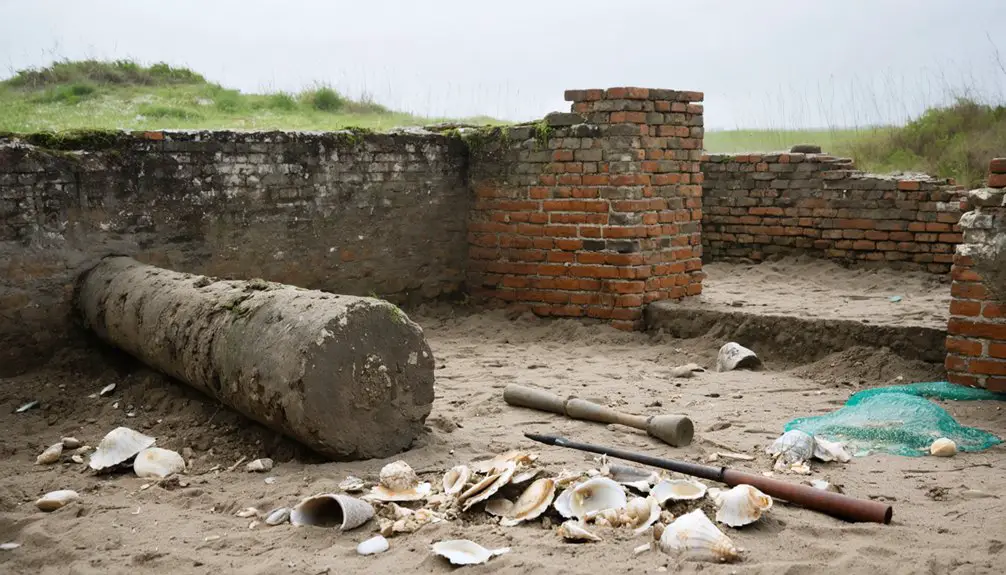
When you examine Brunswick Town’s archaeological record, you’ll find remarkably preserved colonial building foundations that reveal the town’s original layout and architectural patterns.
The stone foundations of St. Philip’s Anglican Church, dating to 1754, stand as the most prominent above-ground ruins and require careful preservation measures to prevent deterioration.
These structural remains, along with thousands of documented artifacts, continue providing invaluable insights into daily colonial life and construction methods in this once-thriving port town.
Unearthing Colonial Building Foundations
As archaeological excavations continue at Brunswick Town, significant discoveries along the colonial waterfront have revealed a complex network of building foundations and maritime trade infrastructure.
You’ll find preserved wooden beams and frames in the river mud that showcase colonial architecture techniques used by early settlers.
Key discoveries include:
- 47 timbers from La Fortuna shipwreck revealing 18th-century construction methods
- Underwater dock and wharf foundations documenting port activities
- Caribbean timber imports showing extensive trade networks
- Multiple shipwrecks suggesting additional submerged structures
Maritime archaeologists and students use advanced underwater mapping technology to document these finds, while carefully collecting wood samples for dating.
These discoveries are transforming our understanding of Brunswick Town’s role as a crucial colonial port, though erosion and modern activities threaten these irreplaceable remains.
Protecting Historic Church Ruins
The massive ruins of St. Philip’s Church stand as a monument to colonial craftsmanship, with walls nearly 3 feet thick rising more than 24 feet high.
You’ll find these carefully preserved remains at Brunswick Town State Historic Site, where historic preservation efforts focus on maintaining the architectural integrity of North Carolina’s once-largest colonial church.
The ruins face ongoing challenges from weather exposure and vegetation growth, requiring specialized conservation techniques.
You can explore the stabilized brick walls that have endured since British forces burned the church in 1776.
The site’s management balances preservation needs with public access, allowing you to experience this authentic piece of colonial heritage while protecting it for future generations.
Regular monitoring and minimal intervention help maintain the church’s historical character as both a Revolutionary War remnant and Civil War military position.
Life in 18th Century Brunswick
During its heyday, Brunswick Town flourished as a bustling colonial port where social stratification, commerce, and political power intersected.
You’d find a vibrant colonial economy driven by merchants and planters, with social hierarchy evident in the daily interactions between prominent citizens and common laborers.
Life in Brunswick Town revolved around:
- Naval store production and exports, with tar, pitch, and turpentine shaping the workday
- Religious gatherings at St. Philip’s Church, where social status influenced seating arrangements
- Political meetings at the courthouse, where royal governors and their councils made decisions
- Maritime commerce, as oceangoing vessels brought traders and seamen to the bustling port
The town’s proximity to swamps and the Cape Fear River defined settlers’ routines, while the presence of two royal governors at nearby Russellborough enhanced its political significance.
Three Centuries of Military History
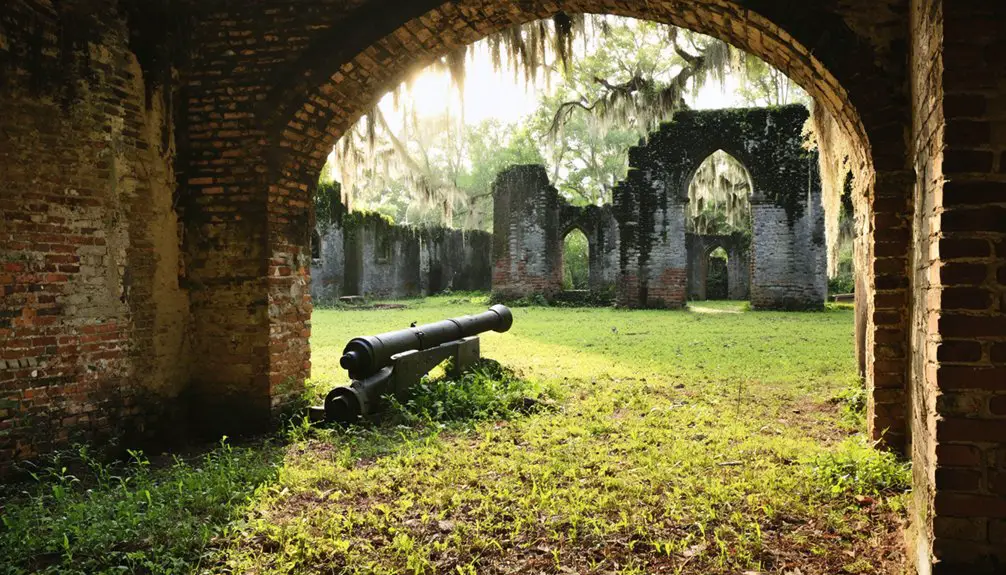
Military conflict shaped Brunswick Town’s destiny across three distinct periods of American warfare, transforming it from a thriving colonial port into a strategic military outpost.
During the Revolutionary War, British military tactics focused on disrupting colonial supply lines along the Cape Fear River.
You’ll find evidence of Cornwallis’s 1776 raid, where 900 Redcoats attacked the town, though Patriots had wisely withdrawn their artillery.
British naval forces supported ground operations from the river, while local militias employed guerrilla-style resistance.
Legacy of Colonial Resistance
When you explore Brunswick Town’s ruins today, you’ll find archaeological evidence of the first organized resistance to Britain’s Stamp Act in colonial America, where citizens boldly boycotted the taxation and placed Governor Tryon under house arrest in 1766.
Through artifacts recovered from merchant homes and public buildings, you can trace how this port town’s economic power enabled sustained opposition to British authority, fundamentally shifting the balance of colonial control.
The site’s preserved structures, including St. Philip’s Church ruins and excavated colonial foundations, reveal how Brunswick Town’s defiant stance against British taxation ultimately led to its fiery destruction in 1776 and its transformation into an enduring symbol of American resistance.
Anti-Stamp Act Movement
The Stamp Act of 1765 sparked unprecedented colonial resistance that fundamentally shaped Brunswick Town’s role in early American protest movements.
You’ll discover how colonists united against British taxation through coordinated economic and political actions that demonstrated their growing desire for self-governance.
The colonial response in Brunswick Town reflected wider American resistance through:
- Merchant-led boycotts of British goods and support for local manufacturing
- Participation in the Stamp Act Congress’s united colonial front
- Social pressure on stamp distributors through public demonstrations
- Legal challenges asserting colonists’ rights as British subjects
This resistance exemplified Brunswick Town’s commitment to the principle of “no taxation without representation,” establishing a foundation for future revolutionary activities.
The town’s merchants and citizens joined the colonies’ first coordinated protest movement, forever changing colonial-British relations.
Colonial Power Shift
During Brunswick Town’s colonial heyday, shifts in political power greatly reshaped North Carolina’s governance landscape.
You’ll find evidence of this transformation in the town’s courthouse, where the Governor’s Council regularly convened, establishing Brunswick as the colony’s de facto capital. Local elites, like Maurice Moore, wielded considerable influence through legislative and judicial roles, reflecting the town’s colonial governance structure.
However, Brunswick’s political dominance began to wane when Governor William Tryon relocated the capital to New Bern in 1770.
While the town maintained its position as Brunswick County’s seat until 1779, its provincial status diminished greatly. This power shift, combined with mounting tensions between colonists and British authorities, ultimately contributed to the town’s declining influence in North Carolina’s political sphere.
Frequently Asked Questions
What Were the Most Common Diseases Affecting Brunswick Town’s Colonial Population?
You’d have encountered widespread disease prevalence including malaria, dysentery, typhoid fever, smallpox, and yellow fever – all particularly challenging due to colonial medicine’s limitations in coastal environmental conditions.
How Much Did Typical Goods and Services Cost in Brunswick Town?
You’d have found colonial currency fluctuating widely, with market prices varying based on trade conditions. Basic goods like flour cost a few shillings, while imported luxuries commanded premium rates in pounds sterling.
What Happened to the Residents’ Possessions When They Fled Brunswick?
You’ll find their possessions were largely abandoned in homes during the hasty 1775 evacuation, with British forces later destroying or looting the remaining artifacts, as historical inventory and excavations reveal.
Were There Any Documented Paranormal Experiences at Brunswick Town Ruins?
You’ll find reports of ghost sightings throughout Brunswick’s ruins, with visitors claiming to see colonial figures and soldiers. Modern paranormal investigations document unexplained sounds, cold spots, and apparent apparitions.
What Types of Ships Commonly Anchored at Brunswick Town’s Port?
Like ships passing through time’s mist, you’d have seen Spanish privateers like *La Fortuna*, colonial merchant vessels carrying naval stores, British military patrol ships, and trading schooners anchored in Brunswick’s bustling maritime hub.
References
- https://en.wikipedia.org/wiki/Brunswick_Town
- https://www.heritagedaily.com/2021/03/brunswick-town-the-abandoned-colonial-town-in-north-carolina/138101
- https://thevintagetraveler.wordpress.com/2020/10/15/brunswick-town-north-carolina/
- https://www.youtube.com/watch?v=FCAvAQZHo2Q
- https://pastlanetravels.com/colonial-ruins-of-brunswick-town-nc/
- https://www.carolana.com/NC/Counties/brunswick_county_nc.html
- https://www.nhcgov.com/DocumentCenter/View/4661/Native-Americans
- https://historicsites.nc.gov/all-sites/brunswick-town-and-fort-anderson/history
- https://news.ecu.edu/2025/08/04/archaeologists-discover-four-at-risk-shipwrecks-on-colonial-waterfront-at-brunswick-town-fort-anderson-state-historic-site/
- https://amrevnc.com/brunswick-town/
